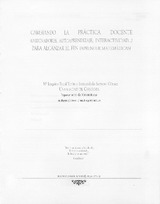Mostrar el registro sencillo del ítem
Cambiando la práctica docente (ordenadores, autoaprendizaje, interactividad ...) para alcanzar el fin (aprender Matemáticas)
| dc.contributor.author | Serrano Gómez, Inmaculada | |
| dc.contributor.author | Berral-Yerón, Joaquina | |
| dc.date.accessioned | 2011-05-24T09:00:06Z | |
| dc.date.available | 2011-05-24T09:00:06Z | |
| dc.date.issued | 2004 | |
| dc.identifier.issn | 1697-1531 | |
| dc.identifier.uri | http://hdl.handle.net/10396/4995 | |
| dc.description.abstract | With the aim of adapting the European Credit Transfer System (ECTS), we attempt to give a new focus to an optional subject in the three-year degree programmes of Computer System Engineering and Computer Management Engineering. To this end, we designed a pilot scheme in which course objectives were achieved in the form of interactive, student-centred learning notebooks that can be used to aid students in learning mathematical concepts. In this way, when the number of classroom hours for first-year subjects are reduced, students can be provided with supplementary materials to aid them in their learning outcome. The main objective of the scheme was to design interactive materials and encourage the student to take an active role in their own learning process. In order to achieve both aims, students were asked to do research on a math-related topic and devise interactive programs of study. | en |
| dc.description.abstract | Ante la necesidad de adaptarnos al sistema de créditos europeos ECTS, pensamos que podíamos enfocar de forma diferente la práctica docente de una asignatura optativa de dos titulaciones de Ingeniería Técnica Informática de Sistemas y de Gestión. Se diseñó una experiencia para lograr esta adaptación, pero planificando el trabajo de forma que los resultados obtenidos fueran cuadernos interactivos de autoaprendizaje, que se puedan usar para facilitar la comprensión de los conceptos matemáticos. De esta forma, al reducir las horas presenciales de asignaturas de primer curso se podrá poner a disposición de los estudiantes un material complementario que les ayude en su estudio. El objetivo fundamental era lograr interactividad en los materiales y que los estudiantes que participaban en la experiencia fueran los protagonistas activos de su autoaprendizaje. Para lograr estos dos objetivos se les pidió que realizaran una investigación de un tema de matemáticas y diseñaran los pasos a seguir para proclamar y conseguir interactividad. | es_ES |
| dc.format.mimetype | application/pdf | es_ES |
| dc.language.iso | spa | es_ES |
| dc.publisher | Universidad de Córdoba, Vicerrectorado de Innovación y Calidad Docente | es_ES |
| dc.rights | https://creativecommons.org/licenses/by-nc-nd/4.0/ | es_ES |
| dc.source | Res Novae Cordubenses (2), 217-236 (2004) | es_ES |
| dc.subject | Selflearning | en |
| dc.subject | Technology of Information and the Computer Science | en |
| dc.subject | Teaching of Mathemarics | en |
| dc.subject | Innovation in teaching | en |
| dc.subject | Mathematica | en |
| dc.subject | Docencia de las Matemáticas | es_ES |
| dc.subject | Autoaprendizaje | es_ES |
| dc.subject | Innovación en enseñanza | es_ES |
| dc.subject | Tecnología de la Información y la Computación | es_ES |
| dc.title | Cambiando la práctica docente (ordenadores, autoaprendizaje, interactividad ...) para alcanzar el fin (aprender Matemáticas) | es_ES |
| dc.type | info:eu-repo/semantics/article | es_ES |
| dc.rights.accessRights | info:eu-repo/semantics/openAccess | es_ES |

